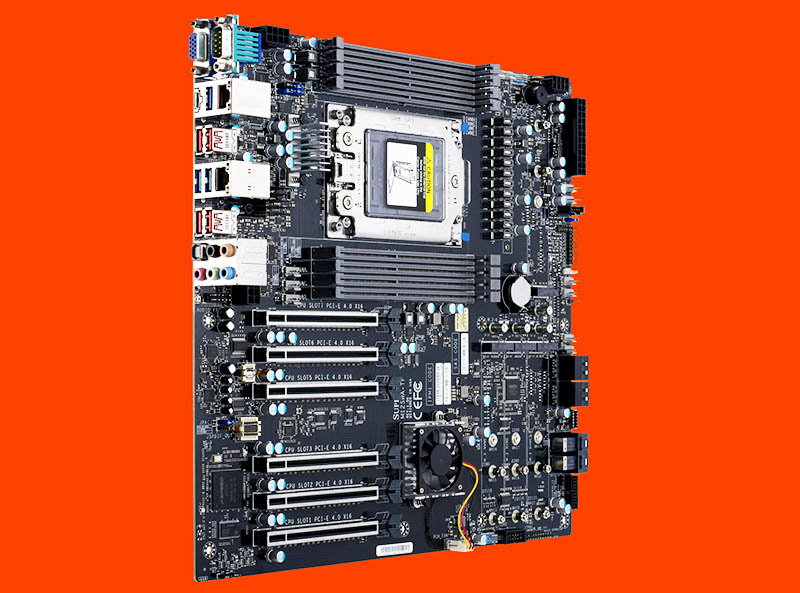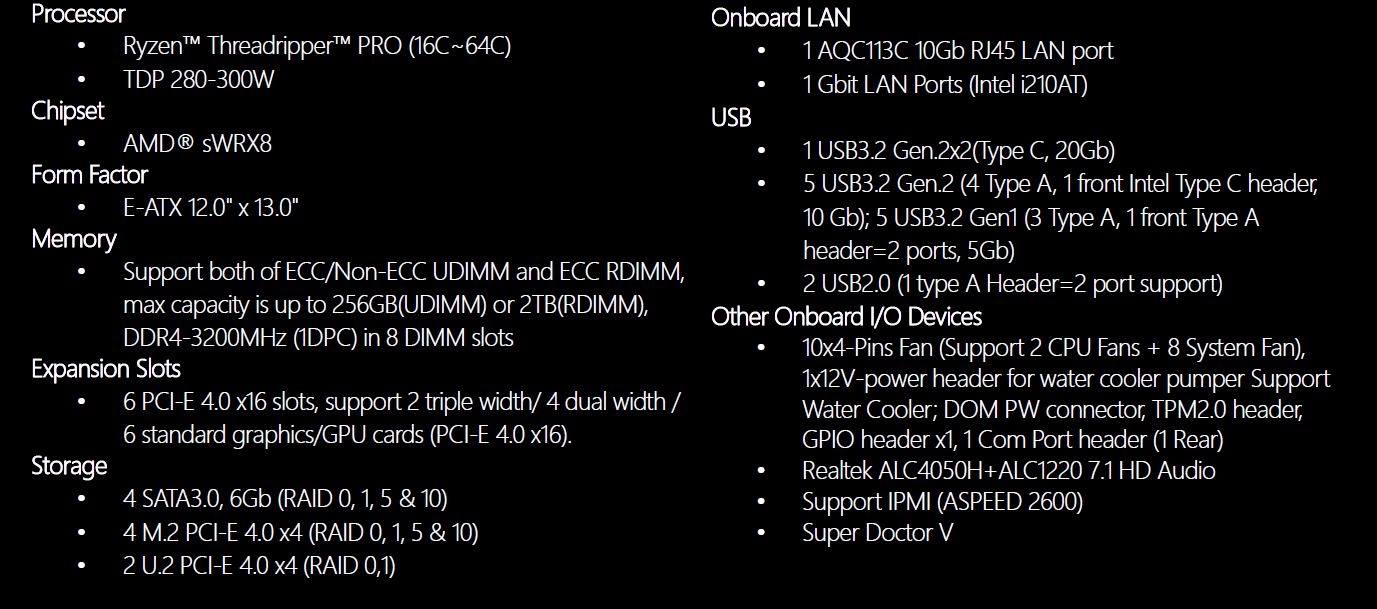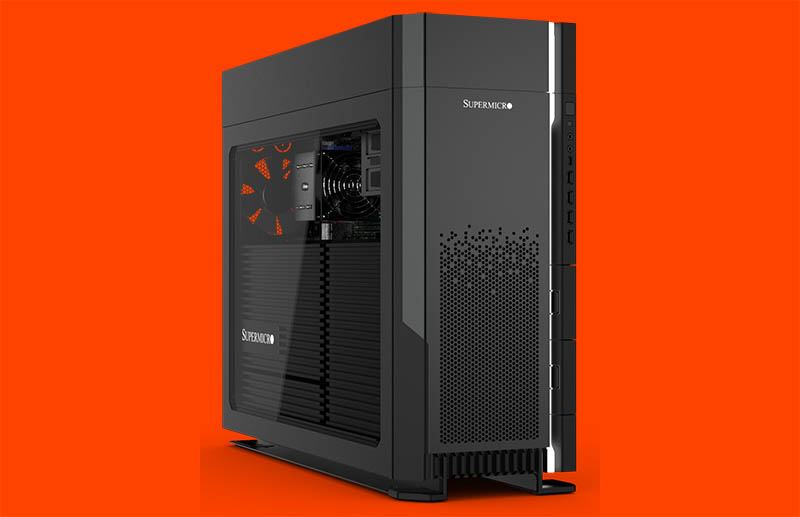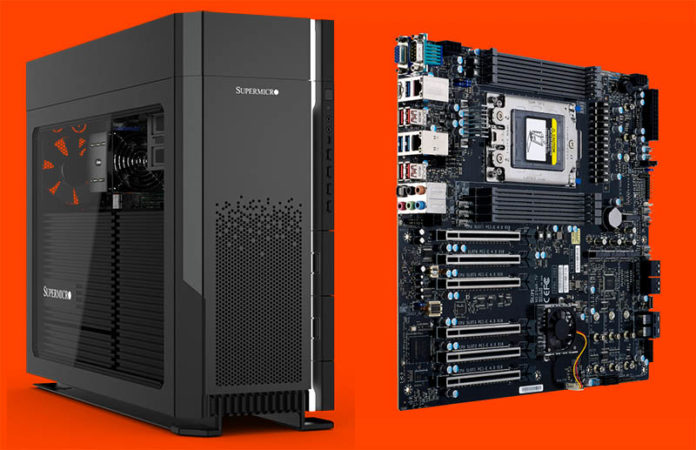Regular STH readers will have seen our AMD Ryzen Threadripper PRO 3995WX Review that was published recently. In that piece and the accompanying video, we opined that the processor series would need to move beyond just the Lenovo ecosystem. That started today. There are a few vendors who are releasing TR Pro or “WEPYC” motherboards, but Supermicro is releasing not just a motherboard, but also a system that can be either a desktop or rackmount workstation as well.
Supermicro AMD Ryzen Threadripper Pro Offerings
Supermicro has offerings both at the motherboard and system level. The system incorporates the motherboard so we will start with the M12SWA-TF and move to the system that is built around it.
Supermicro M12SWA-TF Motherboard
The Supermicro M12SWA-TF is interesting for a number of reasons. First, it is a “Gen 12” motherboard from Supermicro. As such, a standout feature of this platform is that it incorporates the new ASPEED AST2600 BMC for its IPMI out-of-band management.

Here are the key specs of the AMD sWRX8 platform:

Our readers will quickly gravitate to the six PCIe Gen4 x16 slots along with the four M.2 PCIe Gen4 and two U.2 connectivity. There are still four SATA ports, but it is clear that on this next-gen system, SATA is being de-emphasized for more modern NVMe storage. In workstations, there is often fast local storage and then capacity storage is accessed via the network.
One nice feature is that we get the Marvell-Aquantia AQC113C 10Gbase-T controller, but Supermicro also has the Intel i210 NIC. Since the AQC113C is not supported out-of-the-box with all OSes, having the i210 helps one get a necessary driver for the Marvell 10GbE NIC.
This motherboard is an EATX platform, but it is designed for the Supermicro AS-5104A-TT system.
Supermicro AS-5014A-TT System
The Supermicro AS-5014A-TT system is the workstation platform built around the M12SWA-TF motherboard.

This is a standard workstation tower from Supermicro. We are told that there are both air-cooled as well as 360mm closed-loop liquid cooling options for the AMD Ryzen Threadripper Pro CPUs. At a system level, support for 256GB DIMMs gets us up to 2TB of memory supported although that is likely cost-prohibitive for many users. Still, if you need it, it is available and not currently available on the Lenovo ThinkStation P620.
We asked Supermicro and there is an available rackmount kit for this platform. That allows the system to be racked. The front-to-rear airflow of the CPU and DIMMs means that it should work well in a rackmount environment as well.
Overall, it seems as though Supermicro looked at what Lenovo launched and iterated on providing access to more of the platform’s features.
Final Words
There are a few big implications here. First, Supermicro has a more expandable platform than the Lenovo ThinkStation P620. While this may not necessarily matter to Lenovo-only IT shops, those who can buy across vendors will find that Supermicro made several tweaks to “one-up” Lenovo. Further, with features such as IPMI support instead of AMD DASH, Supermicro has a solution that is more suitable for workstation clusters where users remotely log in to centralized workstation resources. While IPMI is not a great remote desktop solution, it does simplify management greatly.
Overall, this looks very cool. Let us know if this is something you would like us to review.





Really wishing there was a seventh PCIe slot like Asus and Gigabyte are doing. Also, need Thunderbolt AIC compatibility for many workstation uses – hope that comes.
I don’t care about the 7th slot. You’d need to make PCIe connectivity trade-offs for it and most are going to have a GPU or two that’ll cover up other PCIe slots.
I’d just like to say this workstation looks like server people trying to be gaming people making a server-y workstation.
I’d want STH to review this since you’ve already done what you call “WEPYC” reviews.
Review it. Shame it’s only 1 USB type C. We need more and less USB 2.0/3.0 ports
no hdmi ?? pity, very pity
List price please.
Nice board. I would hope many of the slots support bifurcation so one would have the option of adding even more NVMe storage.
It would be nice to see a variant that trades two or three slots for 8 or 12 NMVe drives.
A review is a must. But overall, there is no point in reviewing unless there is some information about pricing.
When will this be available?
Love to see a review in a rack mount configuration.
It is a workstation platform the fact HDMI is missing is totally understandable since you are supposed to install a Display Card scalable to your workload
Number of PCIE Gen 4 utilized 6×16″PCIe”=4×4″M.2 NVMe” + 2×4 “U.2” = 120
The CPU is 128 hence few lift for chipset & 10G NIC etc hence adding a 7th PCIe will not be beneficiary since it will be derived by Chipset. Keep in mind this PCI Gen 4 meaning around 2GB/s
Again Patric from STH thanks for the great review & keeping us up to date. It is strange because I watched your P620 review & your first comment was AMD should open the WEPIC platform for other venders. I think you are in the wrong business I think i will mak a furtune in Vegas
Great Job
I wonder if it will be possible to turn the U.2 ports into 4xSATA. I assume the TR Pro uses the same IO die as the Epyc so it should support that at least at the chip level.
Also, I’d be curious if the TR PRo platform supports all encrypted virtualization features of Epyc. But for real – my TR1920X reports the support at the CPU level and my mainboard has settings to enable the support but that’s not enough since it’s missing the support in the platform security processor (I think) so it cannot be made to work. Pity that.
Anyway, please review this board.
“Let us know if this is something you would like us to review”…
Yes, it’s a must!
But IMHO, it should be done in a “different way”. Adding some aspect about TR PRO.
MAIN QUESTION: why should I buy a TR PRO? Only for ECC?
Watching all the benchmarks you have done, the 64core TR 3995wx and 3990x seem to be almost the same. But the “dark side of the moon” is missing. What is missing (IMHO)?
SCALABILITY and MEMORY BOUND SOFTWARE benchmarks.
There are benchmarks that are memory bound and computing intensive, such as:
– Linpack
– CFD Fluid Dynamics (OpenFOAM)
– HPCG (High Performance Conjugate Gradient)
…
In HPCG, for example, 2 x EPYC 8-core could run faster than a 1 x EPYC 64-core!!!
While a 3990x is “very slow” due to the 4-channel limit, with less than half of performance.
In the web, it’s quite impossible to find plots with the scalability “bending point”, where adding more cores doesn’t improve performance because the RAM bandwidth isn’t enough.
So the FINAL ANSWER is:
I buy a TR PRO Workstation to make intensive calculations and the scalability bending point is:
SOFTWARE A = 24 cores
SOFTWARE B = 16 cores
SOFTWARE C = 64 cores
…
So I can spend my money and choose the right
– Type of CPU: MAINSTREAM or HEDT or SERVER?
– Number of cores for the type of applications I run
STH, if you wish, please contact me.
Hope to see soon some computing intensive benchmark.
Regards
Just sell me the board. I don’t care about their case.